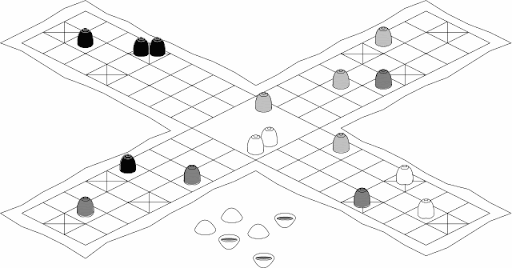Convergent Vs. Divergent Evolution
This essay explores whether the ancient Indian game Pachisi and the Mesoamerican game Patolli share a common ancestor or evolved independently. Early anthropologists argued that their similarities pointed to divergent evolution from a single origin. Later scholars challenged that idea, suggesting the games developed separately yet arrived at comparable designs due to shared human patterns in gameplay and chance. By comparing their boards, mechanics, and cultural contexts, the essay supports the view that Pachisi and Patolli are examples of convergent evolution


There are many theories as to if convergent evolution or divergent evolution is at play between the Indian game of pachisi and the Mesoamerican game of patolli. Adamson Hoebel in 1966 took the stance that Pachisi and Patolli were a divergent evolution(1). Adamson claimed that the two games' similarities were too great to be ignored. Twenty years later, Adamson’s theory was contested by an anthropologist, R. Barry Lewis. Lewis claims that the games were independently derived and that similarities and convergence between the two games are inherent within the limitations of the board game design.
To confirm if these games showcase divergent evolution, we need a direct lineage linking them, which requires archaeological or geographical evidence. Today, two remarkably similar games from distant corners of the world, separated by the Atlantic Ocean, remain unsolved. If we look at Pachisi and Patolli’s aesthetics there are very divergent traits within the games. However, given the vast ocean and timeframes between the two games, I believe they can be categorized as having a convergent evolution. Similar traits that arrive separately through convergent evolution are referred to as being analogous (1). To prove this theory, let’s look into the board and gameplay of each.
Pachisi is a game that originated in India and has been played in India for many centuries and is considered the country's national game. It is described in the ancient text Mahabharata under the name of "Pasha"(2). It is played on a board shaped like a symmetrical cross. A player's pieces move around the board based upon a throw of six or seven cowrie shells, with the number of shells resting with the aperture upward indicating the number of spaces to move. In some versions, a player can move any number of their pieces with a single throw. Also, if the player casts a value higher than they are eligible to move in a single throw, then the player automatically loses that turn.
Patolli was played by a wide range of pre-Columbian Mesoamerican cultures and was known all over Mesoamerica. It’s claimed to have originated by the Teotihuacanos around 200 BC - 650 AD. Patolli is a racing game with a heavy focus on gambling. Players would meet and inspect the items each other had available to gamble. Agreeing to play against someone was not done casually, as the winner of the game would ultimately win all of the opponent's store of offerings. The play area had a similar setup to Pachisi with an "X" shape layout where beans/tokens traveled around the board. The object of patolli is to move six game pieces to the end of a board composed of specially-marked squares. In order to complete a round, a player must get all six of their beans from their starting queue to the ending square before the other player (3).
In conclusion, considering their distinct geographical origins and disparities in gameplay, I believe that Pachisi and Patolli exemplify a case of convergent evolution. While Pachisi and Patolli share certain gameplay resemblances concerning the configuration of the game board, chance-based elements, and the objective of outmaneuvering opponents across the board, it is important to note that they do not stem from identical origins or direct lineages. Both games have a convergent evolution at play with the games evolving independently from each other. Given the geographical disparity between India and Mesoamerica, the two games evolved parallel to one another over time.
Module 3: Evolution of Games, Divergent vs. Convergent Evolution.
https://online.academyart.edu/d2l/le/content/59440/viewContent/2371708/View
